A product of Monaco’s elite youth academy, Soungoutou Magassa made his debut for the Ligue 1 club last season, appearing twice in the top flight and accumulating about 80 minutes of game time.
This season, the 20-year-old has ascended to proper first-team status, having started all of Les Monégasques’ first eight league games this term, starting 11 overall in his first season as a true Monaco senior squad member.
During the first half of this term, Magassa has shown enough quality in one of Europe’s most competitive and challenging leagues to warrant a place in this magazine issue highlighting players and coaches to keep an eye on as we enter 2024. The young centre-back has taken his opportunity in Ligue 1 by the horns and caught the eye while helping his team to improve on their league standing from last season under former Borussia Mönchengladbach coach, Adi Hütter.
This tactical analysis piece in the form of a scout report will provide analysis of Magassa’s role within new Monaco boss Hütter’s tactics that have successfully led Monaco to be sitting in the UEFA Champions League qualification places at the midway point of the 2023/24 campaign, with Les Monégasques having finished sixth last term, failing to qualify for any European football at all.
Our scout report will look at Magassa’s performances through the lens of his role within this team while highlighting the key strengths and weaknesses to be aware of in his game.
Magassa’s profile
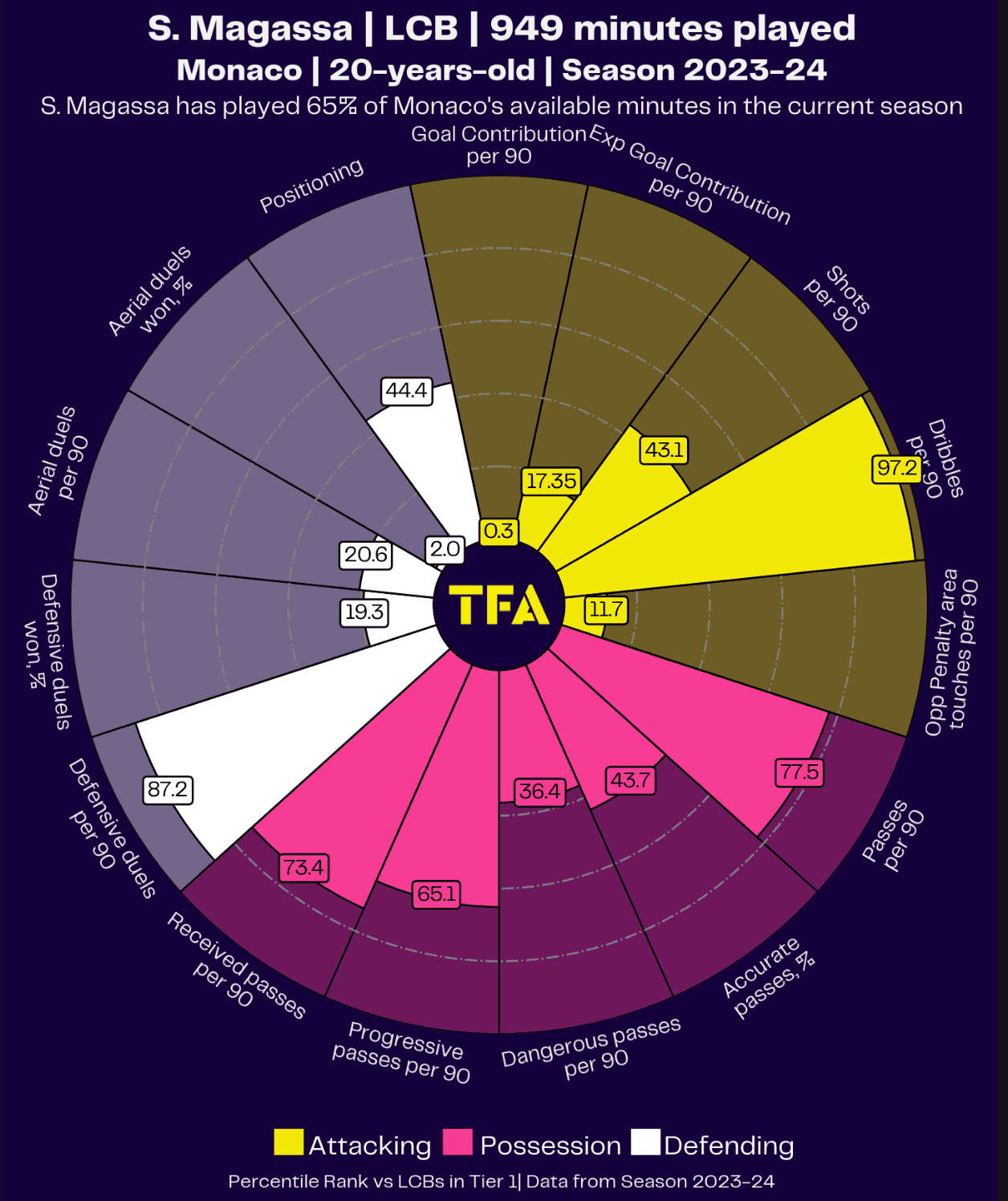
Firstly, if we take a look at figure 1, we can see a pizza chart comparing Magassa’s performance in several notable areas with his peers at the left centre-back position from all ‘Tier 1’ leagues (Ligue 1, EPL, Bundesliga, LaLiga, Serie A), through data.
Indeed, Magassa has primarily been deployed as a left centre-back this season, with Hütter opting to line his side up in some variation of a 3-4-3 in the vast majority of their league games this term.
As per the pizza chart, Magassa ranks in the high percentile range for defensive duels per 90 and dribbles per 90, while his ranking is also very respectable in passes per 90, received passes per 90 and progressive passes per 90.
With Monaco deploying three centre-backs, that gives Magassa, as the wide centre-back on the left, more freedom to engage with attackers than if he were in a two-centre-back partnership, particularly when the opponent tries to attack down the right. We’ll discuss this in much more detail shortly, but this aspect of his squad role is heavily responsible for his high percentile ranking in volume of defensive duels per 90.
As for dribbles and progressive passes, Magassa is clearly very comfortable with the ball at his feet, which we’ll also come to discuss in greater detail shortly. The centre-back likes to carry the ball forward into even more valuable positions when possible and loves stroking the ball forward to teammates occupying useful areas of the pitch for further chance creation, hence the high percentile rankings in dribbles per 90 and progressive passes per 90, respectively.
As a centre-back within a team that likes to dominate possession, it’ll come as no surprise that he receives a lot of the ball in deep positions where he’ll enjoy time and space to exercise his technical passing quality and vision to drive the team forward.
Magassa stands at 188cm/6’2” and weighs 79kg/174lbs, so he’s a decent size for a centre-back. Furthermore, despite playing primarily on the left, he is clearly right-footed.
At youth level, the 20-year-old most regularly played in midfield, either in a holding midfield position or a central midfield position. He gets more time as a centre-back in the top flight, but there are clearly some aspects of his game yet to fully adapt to this position, even if he has stood out in many positive ways this season.
It’s possible he’ll grow in comfort as the season progresses and iron some of these issues out as we continue to observe his development in 2024. However, it’s also possible his future lies in central midfield should he get more comfortable with the fast-paced and physicality of Ligue 1 football.
Again, all of this will be discussed further as we continue with this scout report.
On the ball ability
As we progress deeper into this scout report, our first stop will be to look at Magassa’s on-the-ball ability, with the 188cm centre-back demonstrating a lot of technical quality and composure on the ball at the top level of French football this term.
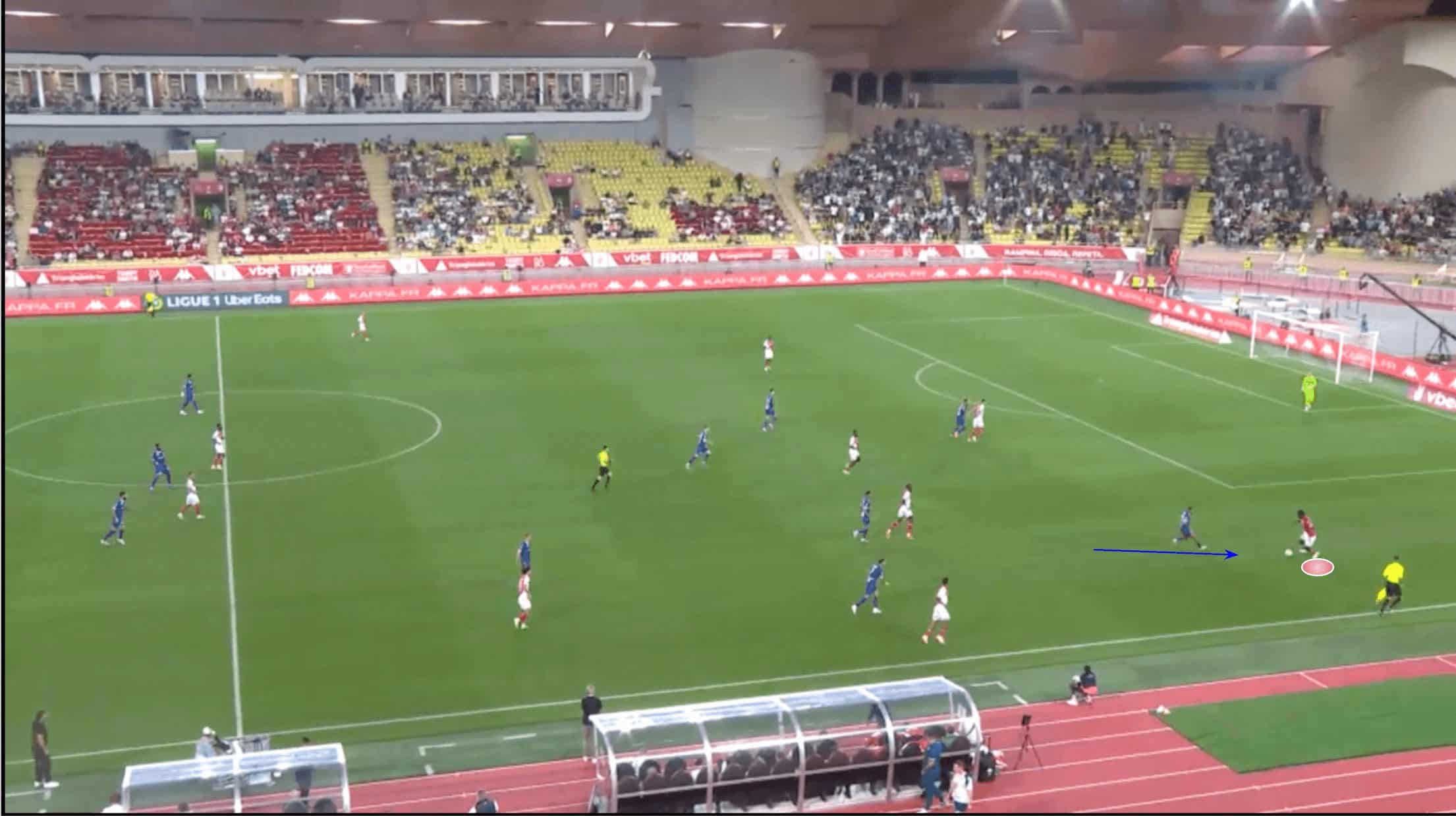
As mentioned earlier, Magassa is extremely comfortable carrying the ball forward. This is true when Monaco are in the progression phase, with the backline situated just behind the halfway line of the pitch, and when the centre-back is under pressure from the opposition’s high block, positioned in deeper areas like we see in figure 2.
In general, when in the progression phase, Magassa likes to carry the ball forward to enter the best possible position to advance the team’s attack to a more desirable position inside the final third. He’s comfortable attracting pressure and confident he’ll be able to get around the opposition’s press and retain possession while driving into better passing positions.
In this example, with the opposition trying to press Monaco high just on the edge of their box, we find Magassa in a 1v1 duel that could be disastrous for his team if he were to come out on the losing side.
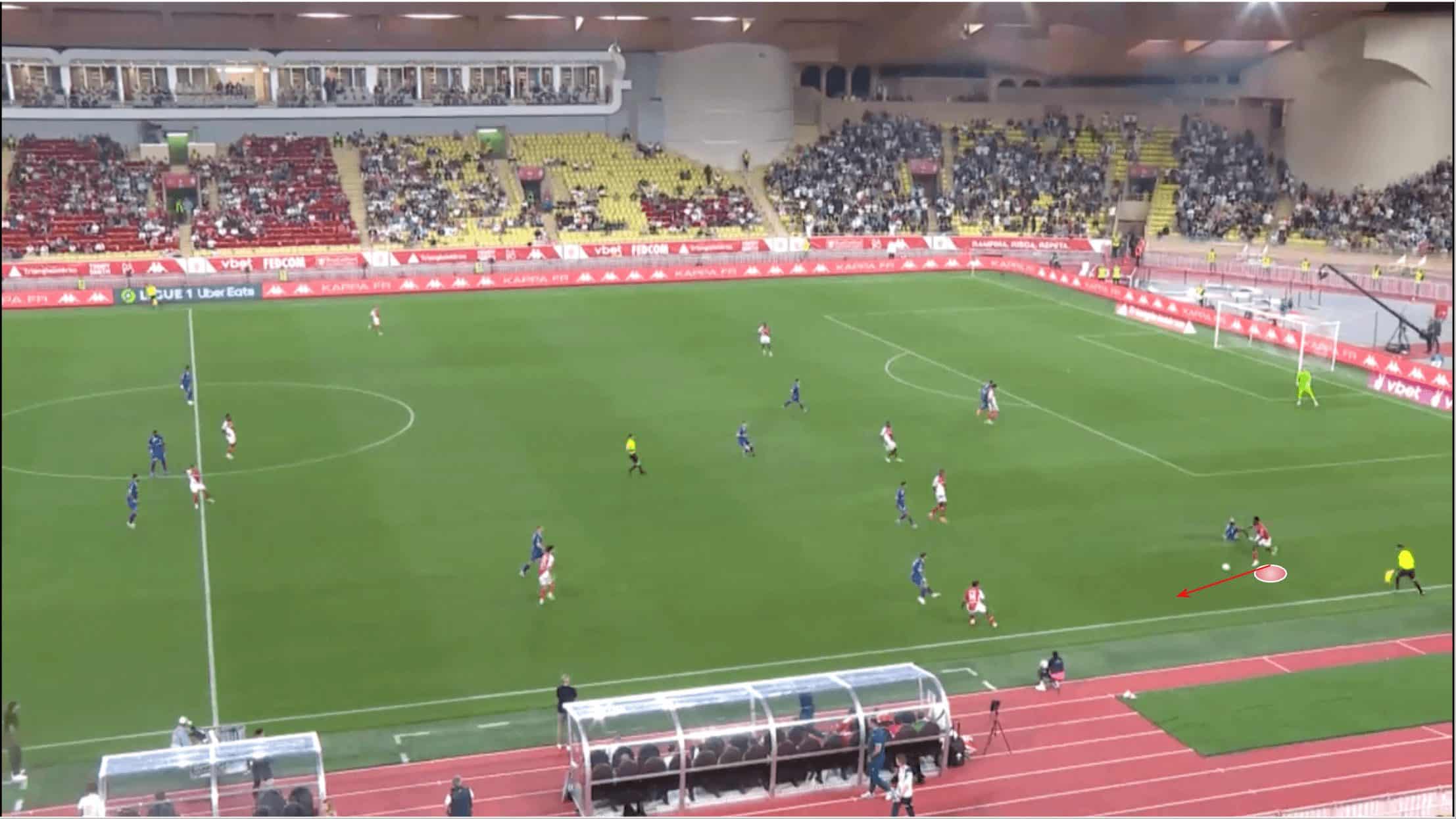
However, as we progress into figure 3, we see that Magassa drew the opposition player and forced them to commit to the 1v1 duel before swiftly escaping to the left, rounding the defender and progressing beyond the opposition’s first line of pressure, opening up some decent progressive passing angles as he moves upfield.
Magassa’s got quick feet and exudes confidence on the ball, even under pressure. Indeed, there are times when this hasn’t worked out 100% to plan this term, and he has lost possession in deep areas, giving the opponent a great chance to attack Monaco’s goal. However, that’s always going to happen with a young, fearless player still fine-tuning his game.
It doesn’t seem any of those errors have had a lasting impact on Magassa’s confidence, which is the most important thing, because these elements of bravery and exhibits of technical quality have benefitted his team far more than they’ve hindered them in 2023/24.
For his ideal strategy to be applied effectively, Hütter will want Magassa to be brave and take on players as they press, showing he’s got the technical quality to beat them 1v1 and progress Monaco effectively from that left centre-back position. This keeps Monaco swiftly moving through the thirds as the Austrian coach wants while retaining control of the ball as they venture into dangerous positions to create further upfield.
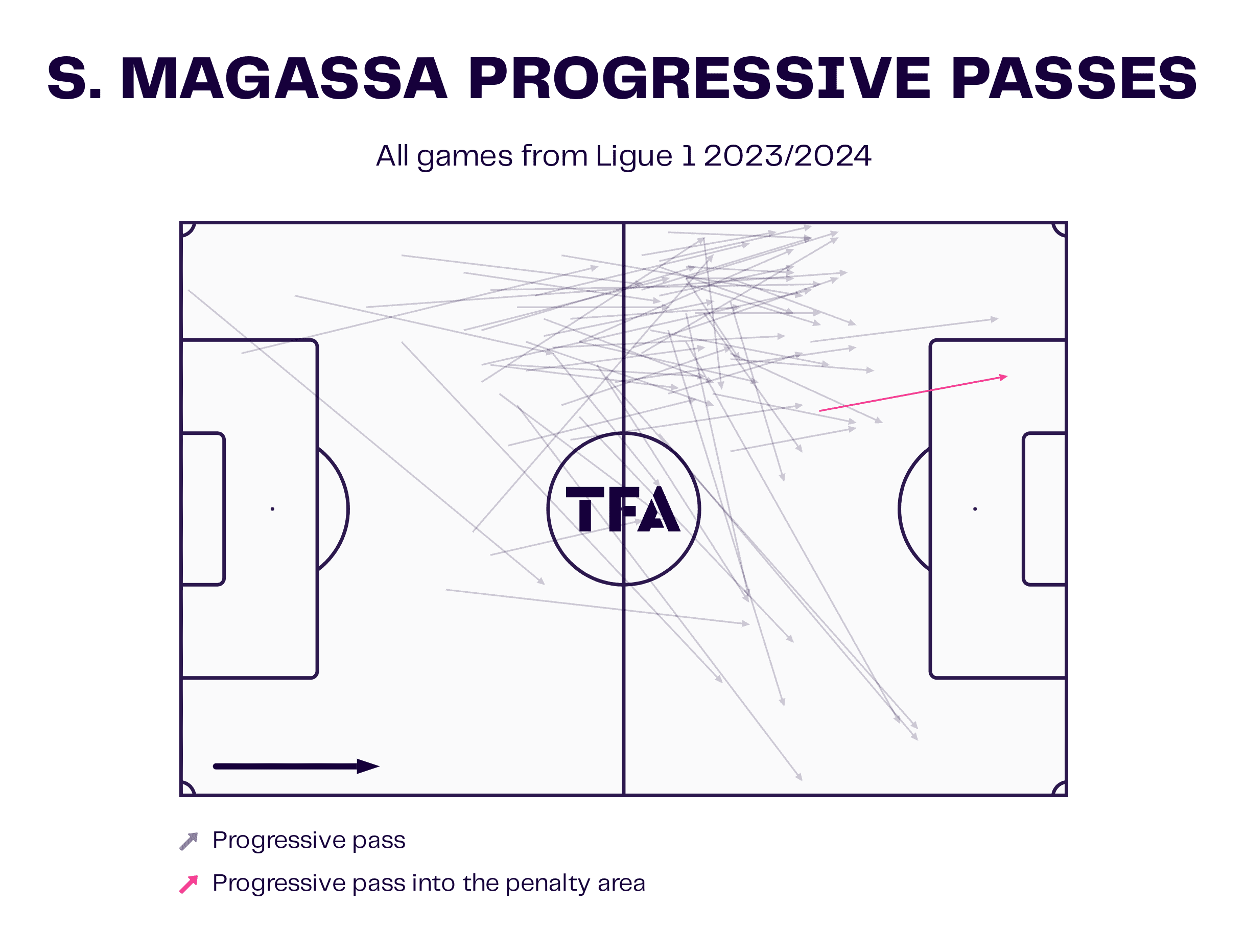
With regard to Magassa’s passing, his progressive pass map here highlights a lot of what needs to be said.
We can see some passes played from well inside the opposition’s half — a result of Magassa carrying the ball into those more valuable positions during the progression phase and launching a penetrating pass into the final third from there.
Big switches of play from the left centre-back position to the right wing are also plentiful, as are passes from left centre-back out to the left wing-back, which typically happen when Magassa is being pressed aggressively from inside on his stronger right foot.
Magassa always has his eye on switching the play from left to right when possible and when advantageous for his side. He doesn’t shy away from playing these balls, and they can be beneficial for Monaco when the team is looking to break through via the wide right channel. They will overload on the left to isolate the overlapping wing-back on the right with his opposite number.
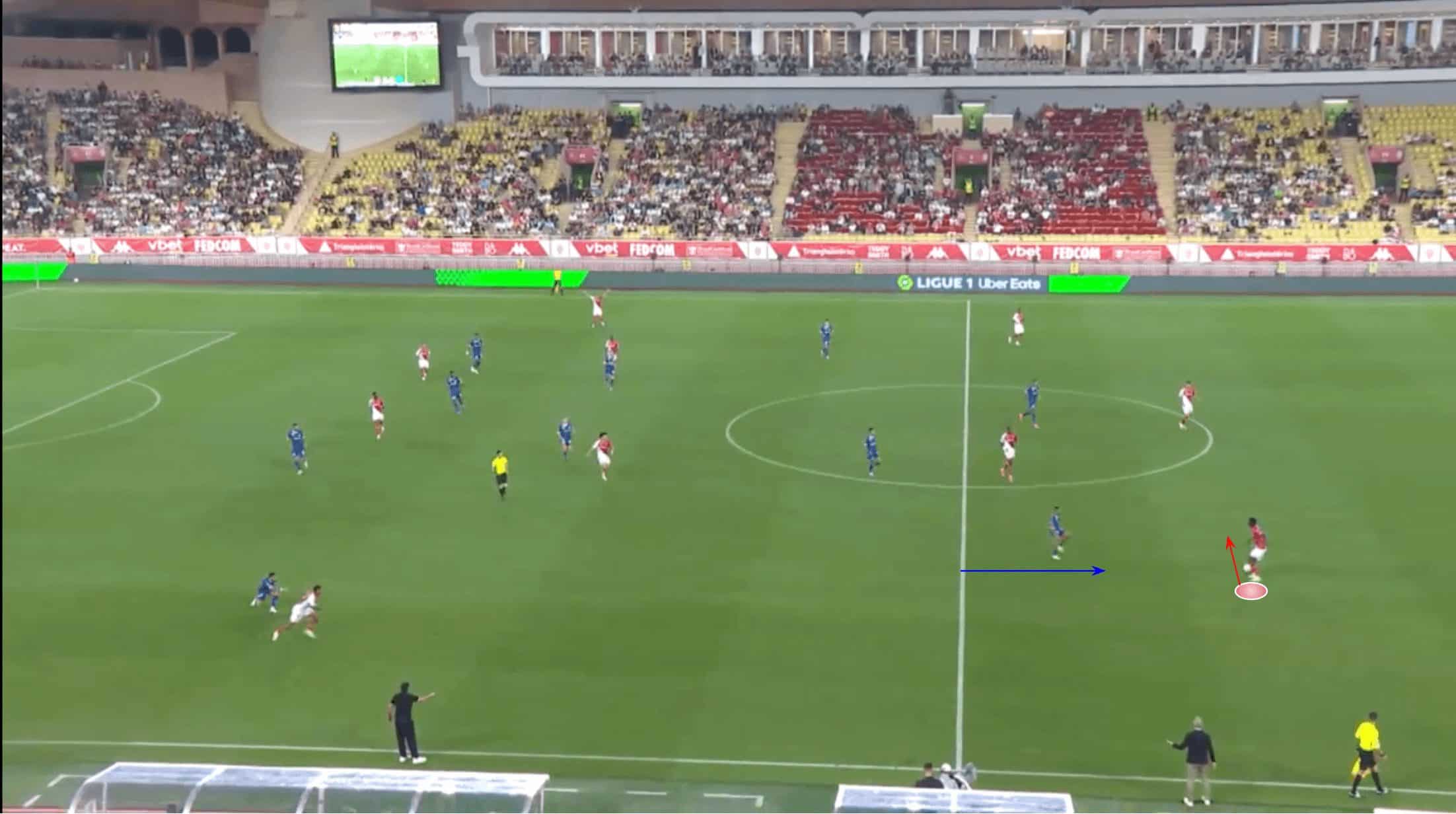
Figure 5 shows an example of Magassa drawing some pressure as he receives on the left with his team in the progression phase. The opposition’s right-winger approaches, aiming to put the 20-year-old under pressure.
Magassa remains calm, shifting the ball onto his stronger right foot while getting his head up to scan the pitch ahead of him and make a final decision on his next move.
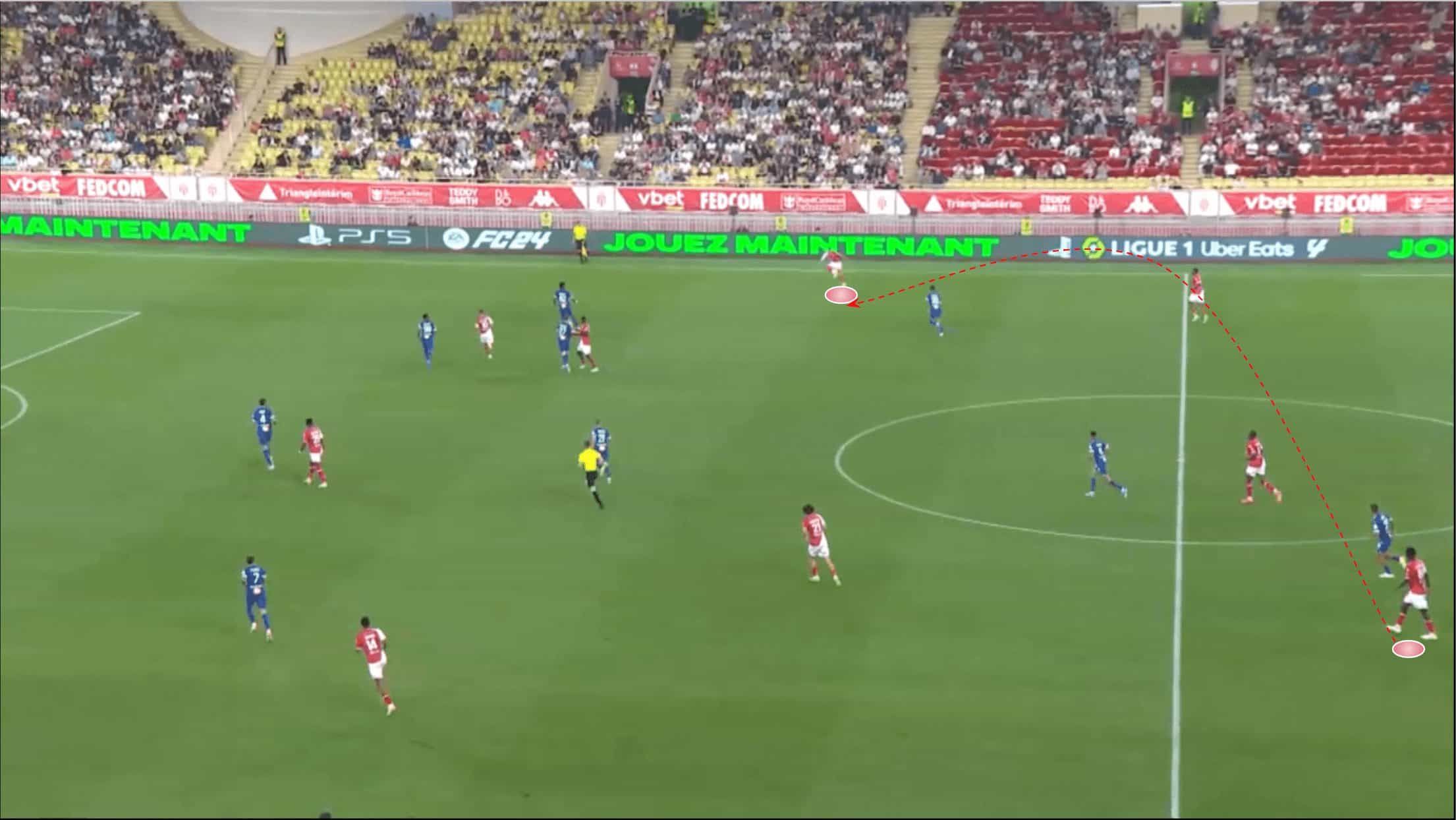
As play moves on, we see that Magassa picked out the right wing-back on the opposite side of the pitch in lots of space to receive and run at the defence, getting Monaco closer to breaking the opposition down and entering the final third.
The pass was well-weighted, and the centre-back used all of the time available before the pressing winger arrived to play the ball, maintaining composure the whole time.
It’s also common to see Magassa looking to play short passing combinations when under pressure, quickly releasing to a nearby teammate and then advancing to try and receive again with more time to pick out a progressive pass.
Magassa’s composure and technical quality typically remain consistent regardless of pass type — a big bonus for Monaco and their possession play.
Defensive attributes
Off the ball, in defensive phases, Magassa’s aggressiveness is the number one thing that immediately jumps out about his game. This is directly a result of his role within Hütter’s three-at-the-back setup, as naturally, Magassa would have to play a more reserved game in a back-two. However, the three-at-the-back setup is also likely one of the main reasons Magassa got his opportunity with the first team at all — so it’s a good match, in essence.
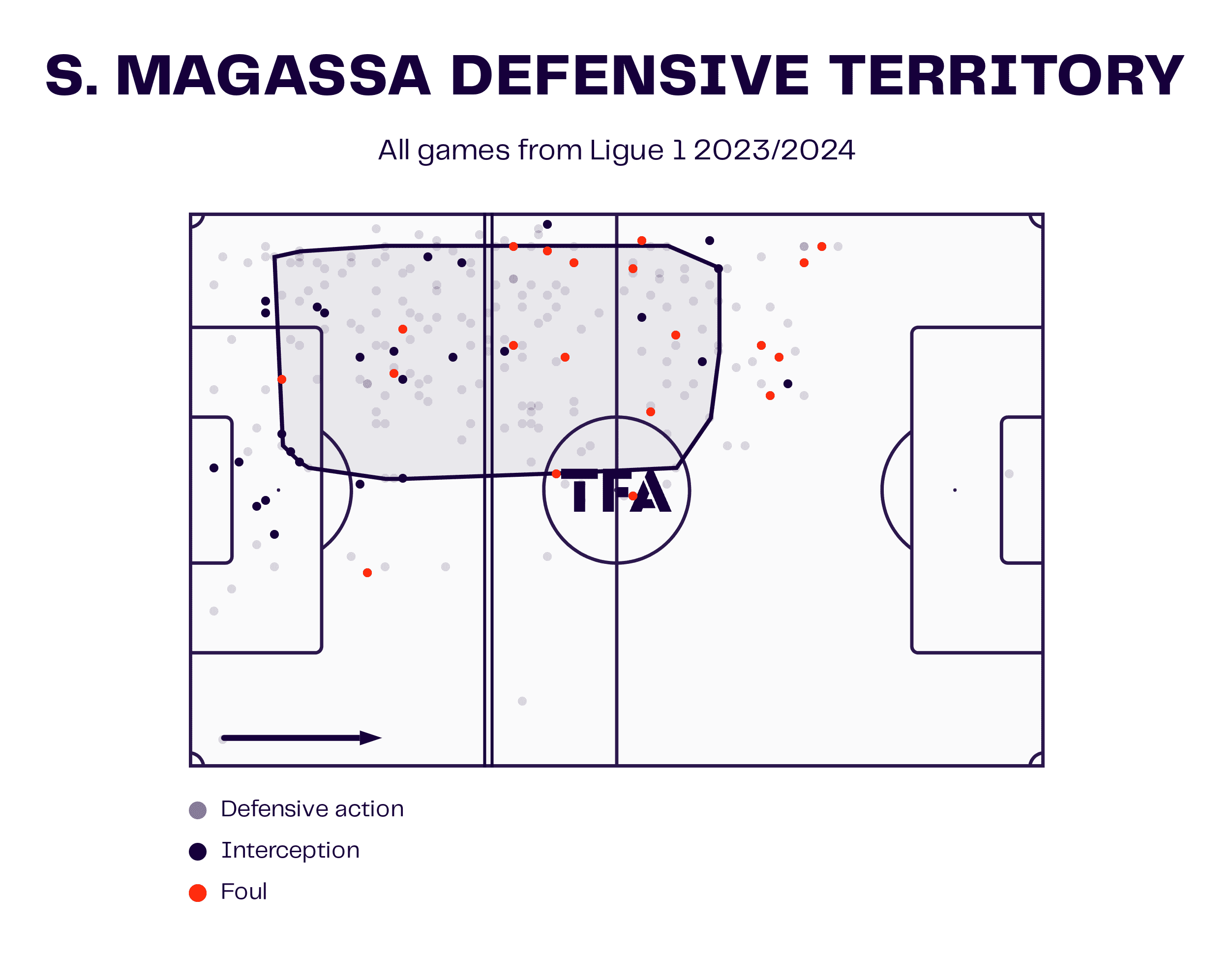
Figure 7 is Magassa’s defensive territory map from the 2023/24 campaign, which further hammers home the point about the young defender being happy to engage attackers in advanced areas — plenty of his defensive duels and interceptions have occurred inside the opposition’s half.
This happens in all defensive phases, as Magassa is Monaco’s most aggressive centre-back and evidently has the licence to jump out of the back frequently, following attackers deep, pressing and tackling to regain possession. He welcomes 1v1 duels and engaging with attackers to prevent them from moving beyond him.
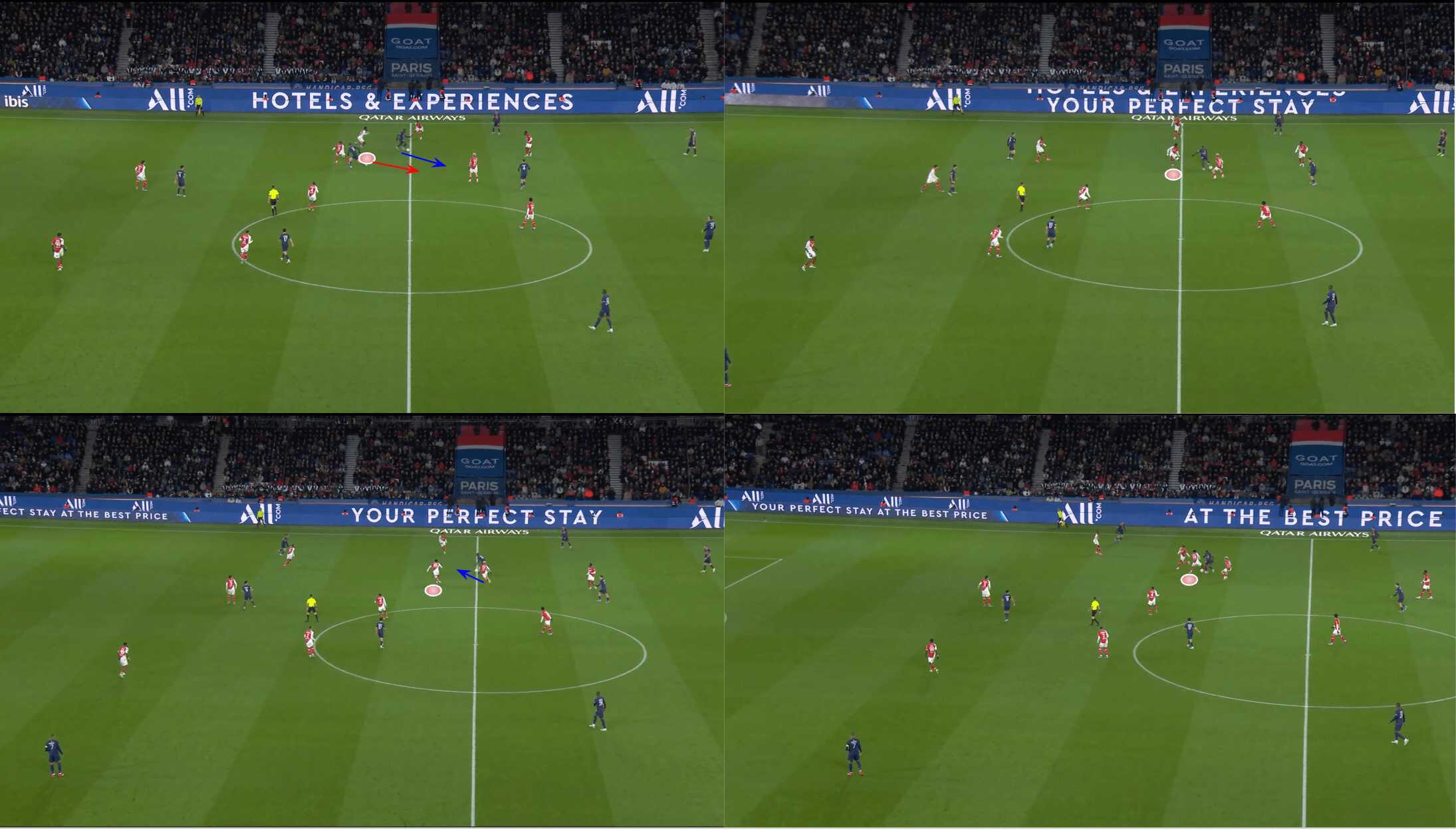
Monaco’s clash with PSG provides a great chance to really assess Magassa’s defensive game critically, as he was matched up directly with an in-form Ousmane Dembélé in this fixture — a highly undesirable job.
There were several occasions when Dembélé exposed Magassa’s aggression in particular during the game, when the winger would receive deep on the right in space, dragging the Monaco centre-back out and into a 1v1 where Dembélé could knock the ball past or around Magassa before exploding into the space now opened up behind the defender.
However, there were also times when Magassa shone a light on his more positive 1v1 defending qualities, such as his ability to position his body intelligently, his spacing between himself and the attacker and his agility, as we can see in figure 8.
All of these qualities are on display here as Magassa is drawn out of the defence to combat Dembélé in midfield. He positioned himself well to prevent Dembélé from getting past, stayed with the tricky winger as he twisted and turned and eventually timed his tackle perfectly to dispossess the PSG man in the middle of the park.
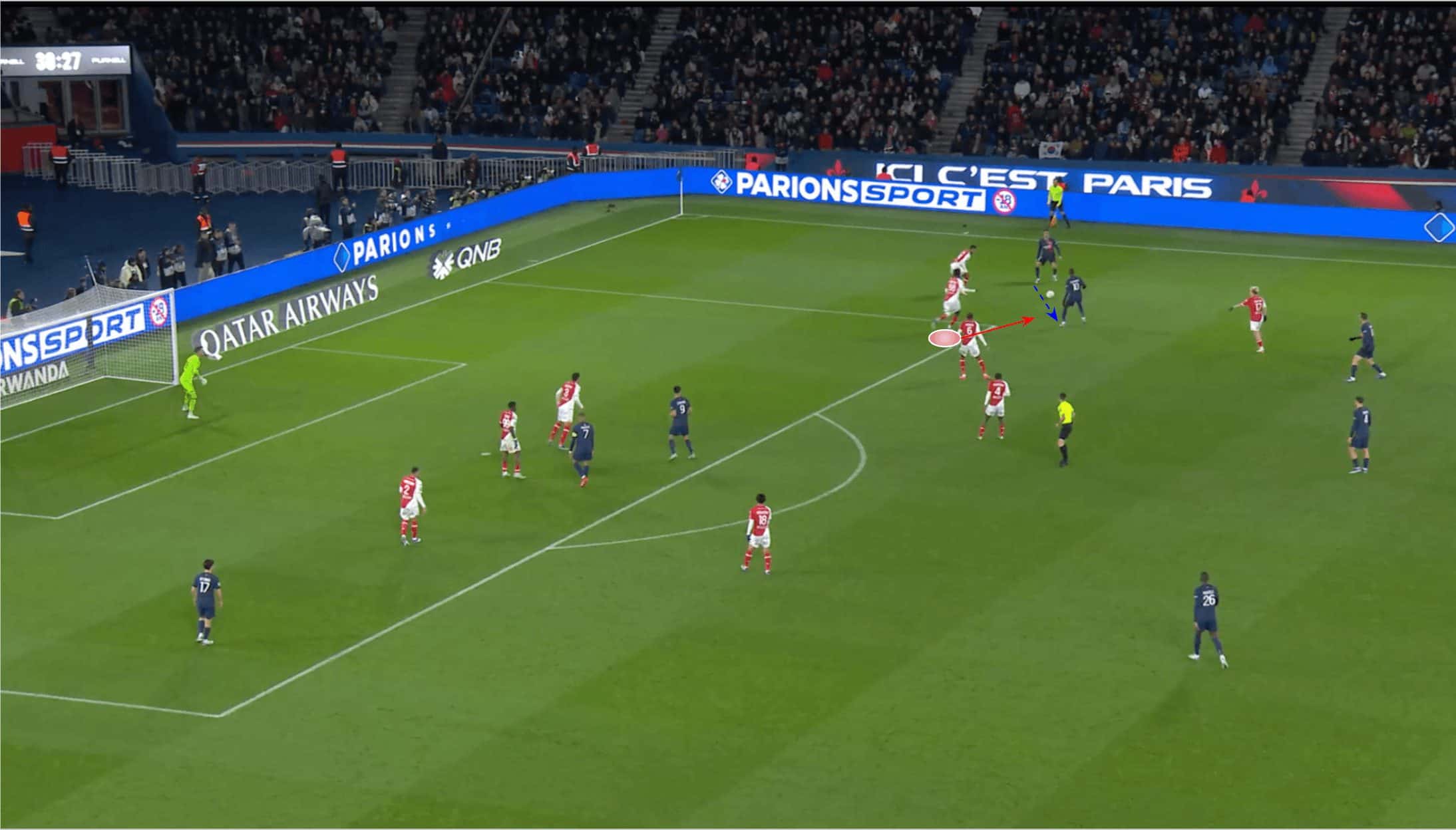
Magassa moves with pace, has fast reactions and reads the game quite well, all of which were on display here as Dembélé received just on the corner of Les Monégasques’ box.
PSG felt safe to play this pass to the winger, who had found some space, but Magassa closed the space very quickly and timed his defensive manoeuvre excellently as we progress into figure 10 to win the ball back for Hütter’s side.
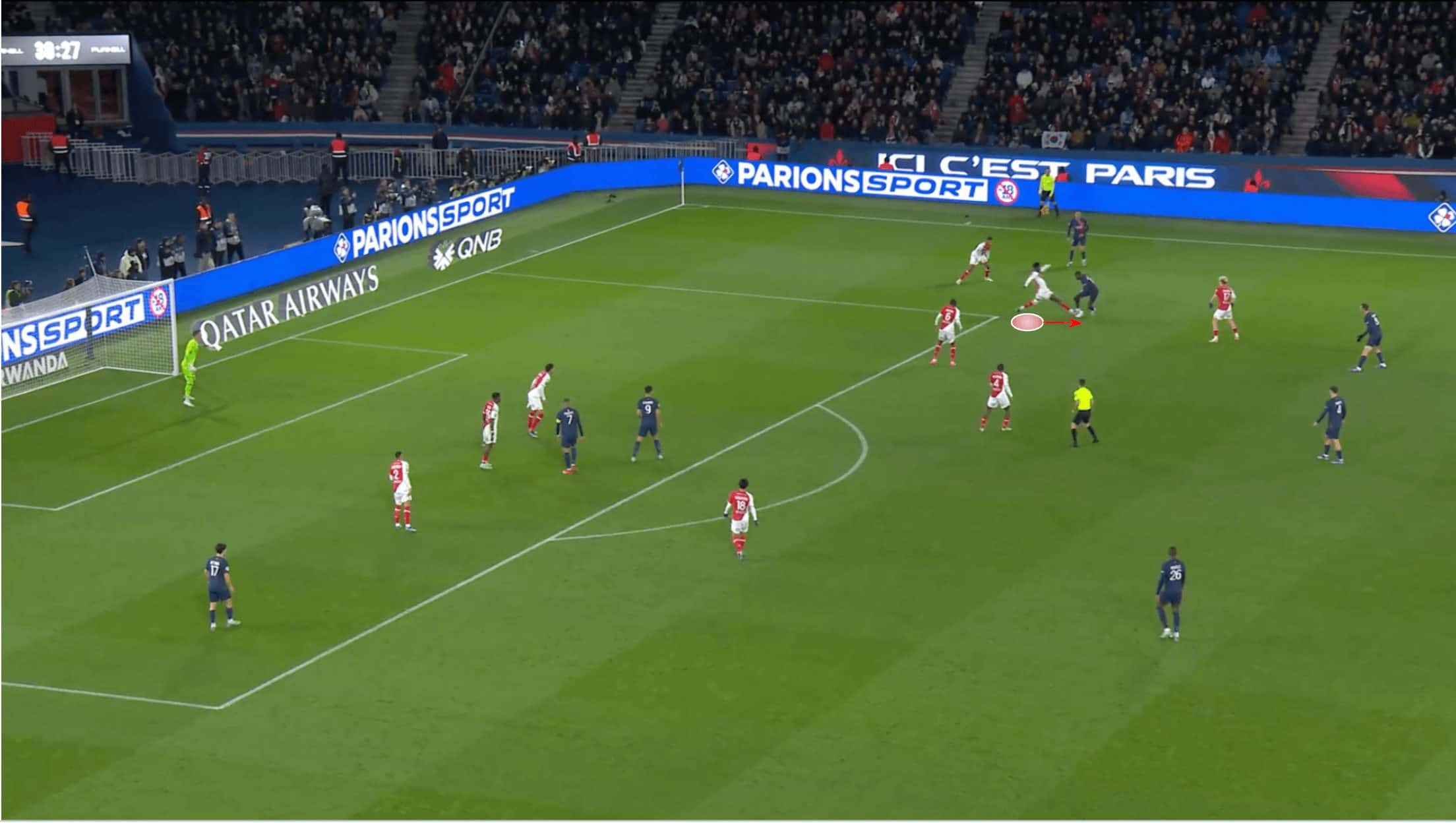
Again, the tackle is very well timed here despite Magassa accepting a 1v1 duel against one of the most in-form attackers in Europe who has extremely quick feet. Again, the player’s bravery is evident from this passage of play, as is the technical quality required to read the game to such a high level and perform such an effective tackle on the edge of the box.
All in all, this PSG clash was not one to remember for Magassa as Les Parisiens ended up scoring five times, and Dembélé gave the young centre-back a hell of a time in constant 1v1 duels, some of which left Magassa for dust — primarily due to being overly aggressive and committing too soon which gave the winger the chance to exercise his elite dribbling quality to move around the 20-year-old.
However, the Monaco man left the contest with an over 50% defensive duel success rate, which is not too shabby considering the quality of direct 1v1 opposition. For a player getting his first taste of top-tier football this term, he showed a lot of positive qualities and left Monaco fans with plenty to be excited about regarding their latest emerging talent.
Aerial ability
In the air, Magassa still leaves a lot to be desired for a 188cm centre-back, though, again, he primarily played in midfield before this season, and this is a quality that can drastically improve with just a few small tweaks.
Magassa has one of the worst aerial duel success percentages among centre-backs in all of Europe’s top-five leagues this season. This is not due to height or physical ‘readiness’ for Ligue 1, as he’s alright in those departments. His high aerial duel failure rate is mainly due to poor timing and poorly judging the flight of the ball.
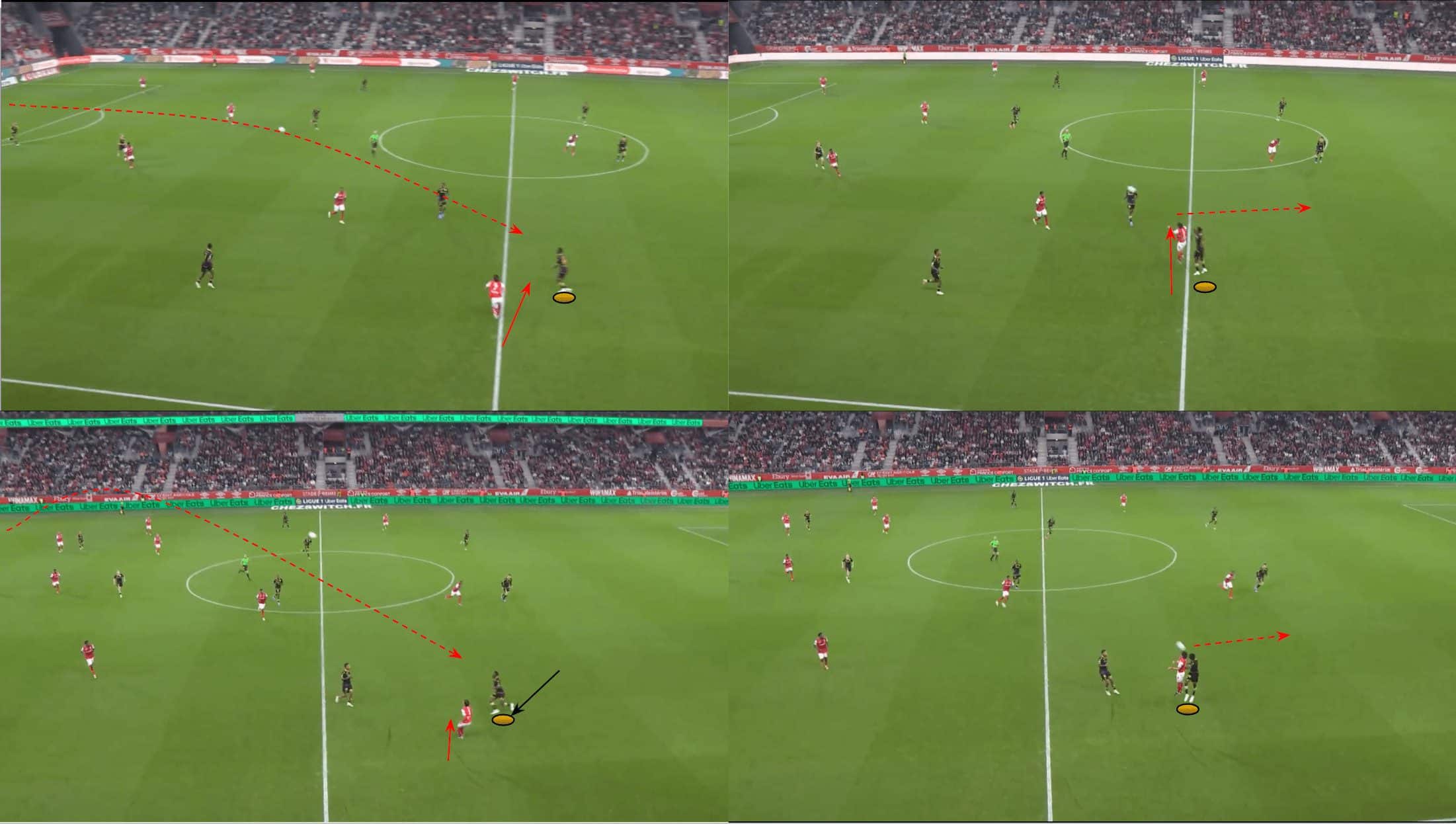
Figure 11 shows a couple of examples of Magassa going up to contest an aerial duel and failing in Monaco’s Ligue 1 meeting with Reims from the seventh of October.
Both of these examples show Magassa losing an aerial duel with 177cm/5’10” Junya Ito, who outjumps the much larger centre-back on each occasion.
The issue here wasn’t physicality, clearly. But on both occasions, Magassa positions himself badly, doesn’t time his jump well and seems hesitant to commit to the header, perhaps due to uncertainty about the flight of the ball. Both examples see Reims get an opportunity to move in behind Magassa and attack Monaco’s backline as a result of the 20-year-old’s failure to win the aerial battle.
There have definitely been plenty of similar examples to this where Magassa does commit to the aerial duel but misses the ball — undoubtedly due to judging the flight poorly on those occasions.
So, some work is definitely required on these fundamental skills when it comes to competing in the air if Magassa is to cement himself as a Ligue 1 centre-back. Until he improves in these areas, he’ll be a target for long balls from the back for the opposition, regardless of who his direct opponent is 1v1.
Conclusion
To conclude this tactical analysis and scout report, we recommend keeping a close eye on Magassa and his development over the next year, with big things likely in the young centre-back’s future.
There are clearly areas of improvement in his game, but that’s typical for a young player — nobody you’ll read about in this magazine is the finished article just yet. Still, all have significant promise, this 20-year-old France U21 international included.
Magassa’s future may lie at centre-back, though he’ll need to fine-tune his defensive game, particularly concerning when he should commit and when it’d be better to hang back and wait before engaging, as well as improve his aerial ability.
A return to midfield is also not out of the question for Magassa — that will depend on how he adjusts to receiving in midfield at the top level, where time and space are at a premium compared to youth levels. There have been occasions we’ve seen the 20-year-old receive with his back to goal in midfield this term and look comfortable. However, consistently doing that at the top level will require more time for adaptation.
Regardless of whether his future lies in midfield or in defence, Magassa is one of the top prospects emerging from one of France’s most productive academies at present, rightfully making a name for himself in his breakthrough season.

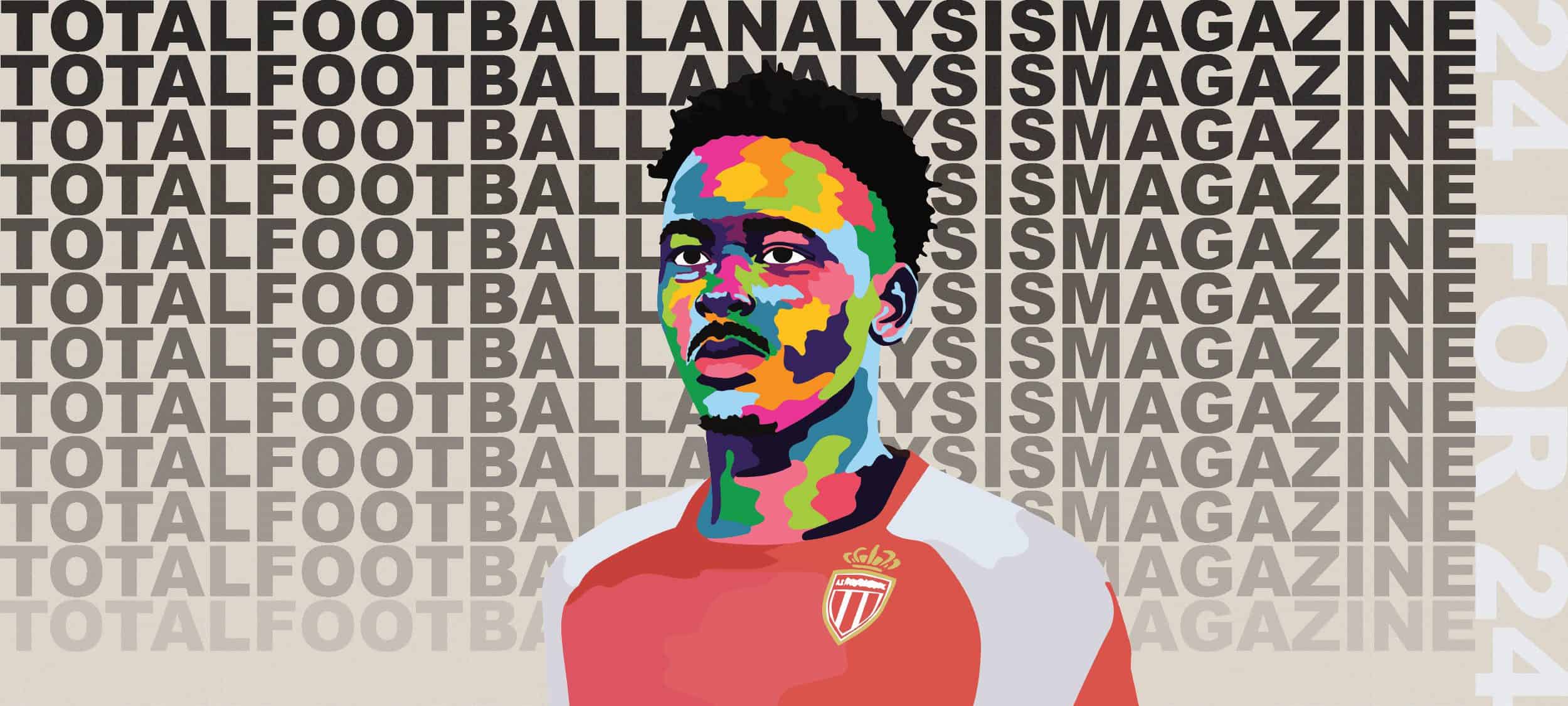



Comments